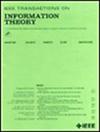Phase Retrieval With Background Information: Decreased References and Efficient Methods
IF 2.2
3区 计算机科学
Q3 COMPUTER SCIENCE, INFORMATION SYSTEMS
引用次数: 0
Abstract
Fourier phase retrieval (PR) is a severely ill-posed inverse problem that arises in various applications. To guarantee a unique solution and relieve the dependence on the initialization, background information can be exploited as a structural prior. However, the requirement for the background information may be challenging when moving to high-resolution imaging. At the same time, the previously proposed projected gradient descent (PGD) method also demands much background information. In this paper, we present an improved theoretical result about the demand for the background information, along with two Douglas Rachford (DR) based methods. Analytically, we demonstrate that the background information required to ensure a unique solution can be decreased by nearly带背景信息的相位检索:减少参考文献和高效方法
傅立叶相位检索(PR)是一个在各种应用中出现的严重求解困难的逆问题。为了保证唯一解并减轻对初始化的依赖,可以利用背景信息作为结构先验。然而,在转向高分辨率成像时,对背景信息的要求可能具有挑战性。同时,之前提出的投影梯度下降(PGD)方法也需要很多背景信息。在本文中,我们提出了一个关于背景信息需求的改进理论结果,以及两种基于 Douglas Rachford(DR)的方法。我们通过分析证明,与一维信号相比,二维信号为确保唯一解所需的背景信息可减少近 1/2$。通过将结果推广到 d 维,我们证明背景信息的长度超过信号的 $/left ({{2^{\frac {d+1}{d}}-1}}/right)$ folds 就足以确保唯一性。同时,我们还分析了当测量和背景信息受到噪声干扰时模型的稳定性和鲁棒性。此外,我们还提出了两种方法,即背景道格拉斯拉赫福德(BDR)和凸背景道格拉斯拉赫福德(CBDR)。BDR 是一种非凸方法,已被证明在温和的假设条件下具有局部 R 线性收敛率。相反,CBDR 方法使用了凸化技术,只要背景信息充足,就能证明它具有全局收敛性保证。为了支持这一点,我们建立了一个名为 F-RIP 的新属性。我们通过模拟和实际实验测量测试了所提方法的性能,并证明与 PGD 方法相比,这些方法在背景信息较少的情况下实现了更高的恢复率。
本文章由计算机程序翻译,如有差异,请以英文原文为准。
求助全文
约1分钟内获得全文
求助全文
来源期刊

IEEE Transactions on Information Theory
工程技术-工程:电子与电气
CiteScore
5.70
自引率
20.00%
发文量
514
审稿时长
12 months
期刊介绍:
The IEEE Transactions on Information Theory is a journal that publishes theoretical and experimental papers concerned with the transmission, processing, and utilization of information. The boundaries of acceptable subject matter are intentionally not sharply delimited. Rather, it is hoped that as the focus of research activity changes, a flexible policy will permit this Transactions to follow suit. Current appropriate topics are best reflected by recent Tables of Contents; they are summarized in the titles of editorial areas that appear on the inside front cover.
 求助内容:
求助内容: 应助结果提醒方式:
应助结果提醒方式:


